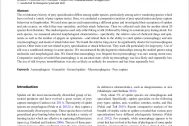Content
The evolutionary history of prey specialisation differs among spider species, particularly among active wandering species which have evolved a variety of prey-capture tactics. Here, we conducted a comparative analysis of prey specialisation and prey capture behaviour in Gnaphosidae. We used nine species each representing a different genus and investigated their acceptance of spiders and ants as prey, on which they may specialise, and their attack behaviour. Then we collected such data for another about 20 species from literature. The studied species used only either biting or silk (followed by biting) to constrain prey during attack. For each species, we measured selected morphological characteristics—specifically, the relative sizes of cheliceral fangs and spinnerets as well as the number of spigots on spinnerets—and related them to the ability to catch spiders (araneophagy) and ants (myrmecophagy) and mode of attack behaviour. We found the relative fang size to be significantly shorter for myrmecophagous species. Other traits were not related to prey specialisation or attack behaviour. They used silk particularly for larger prey. Use of silk was a conditional strategy in some species. We reconstructed the phylogenetic relationships among the studied genera using molecular and morphological data. We found that araneophagy was frequent but myrmecophagy was rare among recent taxa. Comparative analysis revealed that araneophagy is an ancestral state, while myrmecophagy was less likely and repeatedly lost. The use of silk for prey immobilisation was also as likely as unlikely for ancestors and has been repeatedly lost.



